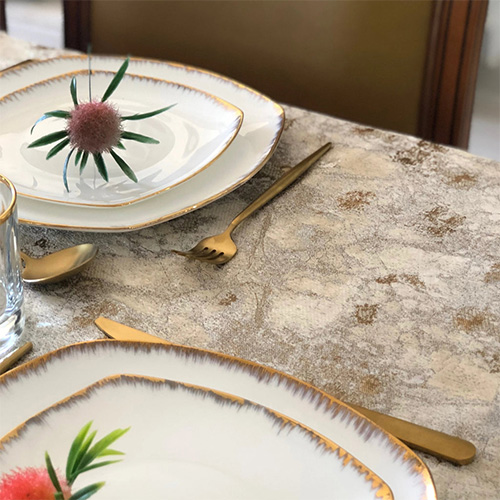Jewish Design and the Shabbos Tablecloth
| August 23, 2022
I love talking about Judaism and design as well as design within Judaism. That is not just because it appears incongruous, since Judaism often emphasizes the spiritual and internal aspects of life, while design seems superficial. Design, rather, like Judaism, is most effective when it’s not limited to superficial looks; when it takes the user into account. Design actually mediates how we move through the world on a physical level and thus is connected to Judaism, which also dictates how we move through the world.
“And let them make Me a sanctuary that I may dwell among them” (Shemos 25:8). Hashem commands us to build His temple. Dictated by Hashem and brought into existence by Betzalel, the design of the Mishkan itself, as well as the items inside, is explicitly spelled out in the Torah because the details mattered. Materiality, physicality, and design matter.
Let us look, therefore, at the holiest day of the week, the time when we rest from creative work, and examine the centrality of design to that day, particularly the table. We are prohibited from sewing, dyeing, constructing, or embroidering on Shabbos because we did all of those things to construct our Mishkan. Shabbos symbolizes a rest that includes not only a physical relaxation but also a rest from creativity and design.
Nevertheless, it is on Shabbos that we are able to unwind and enjoy our creativity, whether through the cooking and baking we did earlier in the day, the arrangement of the table, or the use of the money we made from our occupations to buy the food that we serve.
Setting a beautiful table can be a spiritual act and a concrete way to welcome Shabbos. The tablecloth we lay down, for example, isn’t a specifically Jewish item. And yet when we use that tablecloth to beautify our Shabbos table, we elevate both our Shabbos and the tablecloth. For the Mishkan we used gold, silver, and copper; blue, purple, and crimson yarns, fine linen, goats’ hair; tanned ram skins and acacia woods. For our tablecloths we may use linen, cotton, vinyl, oilcloth, or polyester. We may incorporate larger trends or stay with a classic look. We may dress our table for the season, using velvet in the winter and linen in the summer, or use the same faux alligator-skin tablecloth all year round.
Design reflects our place — where we live at any given moment and how we are doing within that society. Are we wealthy enough to afford elaborately embroidered tablecloths, for example, or do we perhaps live in a place where hand embroidery is a common practice, or do we own one tablecloth of simple white muslin that we use week after week? Do we have servants, allowing us to set tables with an elaborate number of dishes that they will wash for us? We use the resources available to us to elevate the Shabbos table today, through design and creativity, to inspire a feeling of rest, kinship, and spirituality.
By no means does this mean that our tables are worthy of Shabbos only if we tablescape and coordinate our napkin rings with our floral arrangements and accent plates with our silverware. Rather, setting the table for our holy day is a way to set a tone and atmosphere, a mood and a readiness for the holiest day of the week.
Both the table covered with a plastic tablecloth and set the same way each week with simple paper goods placed a bit haphazardly by a young helper, as well as the meticulously planned table that coordinates the napkin rings with the floral arrangements, serve Shabbos equally, bringing to us that sense of calm, rest, and holiness that we associate when we see a table with a challah tray, a challah cover, and a clean kos, filled and ready for Kiddush.

Rose Sketch LINEN
worldofhart.com

Gold Stone
elegancetableware.com

Sabbath tablecloth
www.imj.org.il

Partially embroidered tablecloth
collections.ushmm.org
Shoshana Batya Greenwald is a educator, program associate, and design historian living in New Jersey. She is passionate about empowering Jewish women and fighting anti-Semitism.
(Originally featured in Family Room, Issue 31)
Oops! We could not locate your form.







